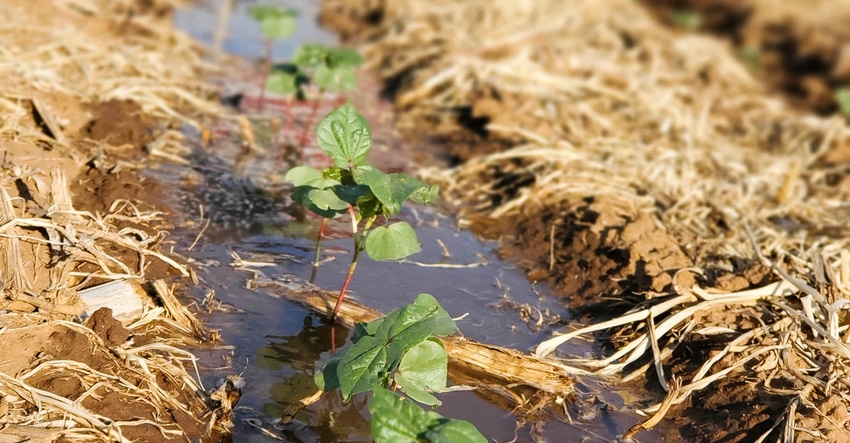
The market for agricultural ecosystem asset credit opportunities, such as carbon, is developing rapidly, according to Economist Shelby Myers, American Farm Bureau Federation.
"They're changing regularly. I've changed this presentation multiple times," Myers said at the “Carbon Farming in Texas Seminar,” Tuesday, May 11.
 American Farm Bureau Federation Economist Shelby Myers. (Photo courtesy of American Farm Bureau Federation)
American Farm Bureau Federation Economist Shelby Myers. (Photo courtesy of American Farm Bureau Federation)
Agricultural ecosystem asset credit opportunities are voluntary, incentive-based national markets designed to put buyers and sellers together on one platform and allow the exchange of Agricultural ecosystem asset credits.
"Farmers and ranchers who want to earn money selling these have to opt into some version of data monitoring and measurement to participate," said Myers.
Payments are typically based on outcomes or pay for practice. " A payment by outcome is typically paid on a per metric ton of ecosystem benefit, like carbon sequestered or methane captured; whereas a pay for practice is typically a per acre payment -- for example, paying $10 per acre for cover crops, $10 per acre for no-till implementation," Myers said.
See, Be patient on selling carbon credits
Some conservation practices that generate credits are conservation cover, cover crops, crop rotation, livestock rotation, no-till/strip-till, anaerobic digesters, nutrient management, buffer strips and tree/shrub establishment.
But before these practices can be turned into a credit, they must be quantified. Producers will have to prove that the conservation practices implemented generate the benefit they agreed to generate, Myers said. "Then the participating program can quantify it into a credit."
Those credits must be verified by a participating third-party verifier before arriving on a market for buyers who want the credit.
"When we're talking about the market developments of these kind of asset markets, we're talking at a really high level. All you have to do is implement the practice agreed upon. The way you do it and how you do it can typically be an individual decision or stipulated in the contract you've signed," Myers explained.
Changes to crop systems could generate additional revenue. Implementing National Resources Conservation Service practices through USDA programs such as EQIP could be possible. "You can implement these USDA NRCS practices on your farm and potentially participate in a credit market."
USDA is working on implementing credit procedures and parameters around how a producer can use the NRCS programs in a sustainability market, Myers added.
Data monitoring measurement
Data monitoring measurement is important, she said, along with understanding the longevity of the contracts. "In a typical NRCS contract, you're not going to sign for longer than 10 years, and that's usually on a CRP contract. Compared to some of these agriculture ecosystem asset credit market participation contracts, they are two, three, five, 10 years, and some want a 100-year-commitment in terms of permanence of benefit."
Once conservation practices are implemented, they can be turned into quantified, verified assets. "We're not just talking about carbon, though carbon is the easiest to talk about. It's the most common greenhouse gas emission. It's the 'big problem' in the climate discussion of what kinds of greenhouse gas emissions are being emitted in high quantities. The practices we do are already easily implemented to sequester carbon."
Across all economic sectors in the U.S., the land use, land change category -- including forestry -- contributes negative 12% of greenhouse gas emissions, Myers said. "So, we have the ability to capture 12% of what other industries are emitting. When combined with agriculture emissions, which are only 10% of the U.S. total greenhouse gas emissions, agriculture is a net negative emitter instead of a greenhouse gas emitter."
See, Conservation management offers benefits
In addition to carbon, some markets are interested in other greenhouse gas emission credits such as methane, as well as water quality, water quantity, nutrient runoff capture and biodiversity credits that could expand the number of farmers and ranchers implementing conservation practices and getting paid for them who typically may not sequester a large amount of carbon but can contribute other benefits. Think improving wildlife habitat as credits, as well."
Texas may benefit from these other sequestered credits that could be available long term, Myers said.
Once the credits have been verified by a third-party verifier, Myers said they can enter the market where buyers can purchase them to attain their sustainability commitments or to reach compliance standards. Then growers are paid for participation.
Credit purchases
Credits are purchased by corporations, agribusinesses, and governments. Payment can be applied in the form of input discounts or cash payment.
"As an agribusiness customer, they could pay you for the credits you've generated through discounts applied to your purchases of seed or chemical, or it could be a cash payment upfront."
Who and when
Myers broke down the agriculture ecosystem credit market landscape into three categories: public offerings, program administrators, and market-operators, which was further broken down by non-profit and the private industry.
The public proposal option includes items like the Growing Climate Solutions Act, reintroduced in Congress earlier this month. "This bill can help markets develop in the private sector and provide resources from the public sector that can assist farmers and ranchers understand these private markets as they develop so they benefit farmers and ranchers like they should.
“[The Act] calls for USDA to be a resource so we have all the tools available to understand how these markets are evolving, what's changing, and who those reliable third-party verifiers are that USDA has said, 'These are good to go'.
"By creating a taskforce of majority producers, we can have a strong producer voice at the table to say, 'This is where we need the public sector to assist the development of private markets, and here's where we need them to stay out of the way of so private markets can do their thing,'" Myers said.
A Carbon Bank that would run through USDA’s Commodity Credit Corporation has been "proposed as a tool that could enable cost-share assistance and fund pilot projects that would help enable the private sector.
Then we have program administrators and market-operators. "It's important for farmers and ranchers to understand who is partnered up on these projects as program administrators and market-operators, so you know who is at your table at the time of enrollment, and who is involved in activities on your farm, and the data you will be expected to share."
Myers said just because a company announces they have a program doesn't necessarily mean they're running a market.
Farmers need to know who the involved parties are and what kind of contracts they offer.
"This is something we've stressed at Farm Bureau: you're not just opting into getting paid for conservation practices, you're opting into a long-term contractual agreement with data monitoring and sharing with a table of business partners.
"We see a lot of opportunities in these new markets, but also advise to 'walk with caution' to understand all the impacts of participation before jumping into it."
To view the workshop in its entirety, visit https://youtu.be/dWX5usx7LoE.
About the Author(s)
You May Also Like






